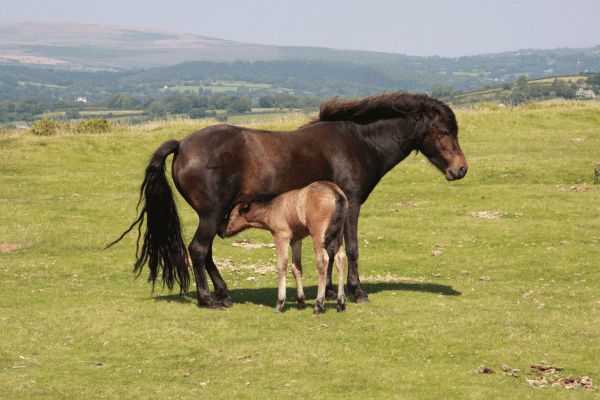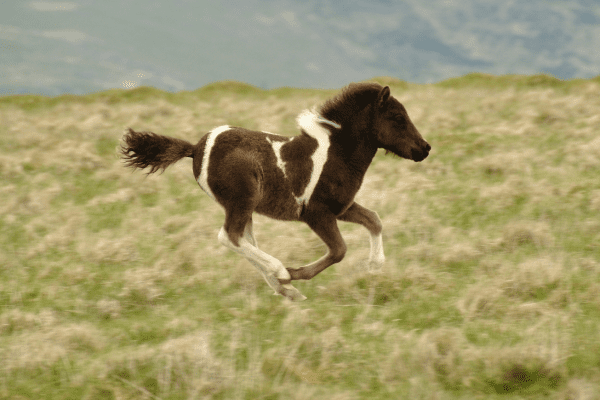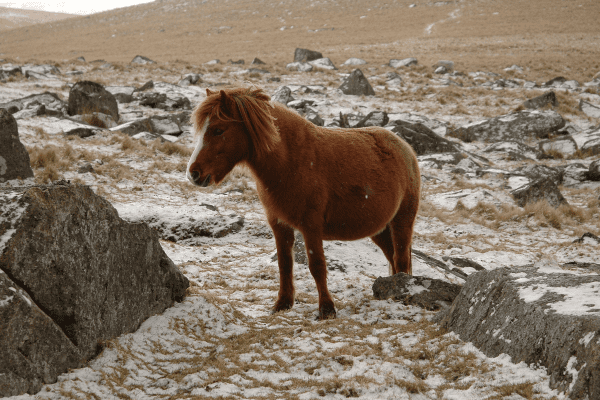Residing in the heart of Devon, England, the Dartmoor Pony is a breed steeped in a rich and enduring legacy. For centuries, this robust and resilient pony has been a fixture in the diverse roles of rural English life.
Renowned for its remarkable stamina and hardy nature, the Dartmoor Pony has historically served as a reliable work companion to tin miners and quarry laborers. Today, these ponies thrive in a semi-feral state, roaming the majestic landscapes of Dartmoor, showcasing a unique blend of independence and adaptability.
Breed Characteristics
The Dartmoor Pony breed, long associated with Devon in England, is celebrated for its combination of elegance and resilience. These ponies inhabiting moorland terrain boast many attractive traits which demonstrate both their adaptability as well as aesthetic charm.
Physical Attributes:
Head and Facial Features: The Dartmoor Pony stands out among breeds by possessing an adorable small head with wide-set eyes that exude alertness and intelligence, balanced out by poised ears that enhance its expressive facial structure.
Body Structure: This breed boasts a compact but robust build, marked by its deep and broad ribcage of medium length. This sturdy build attests to their strength and endurance honed through years of living on Dartmoor terrain.
Limbs and Movement: The Dartmoor’s limbs are an example of strength and efficiency in horses. From body to knee and hock, the legs become long cannons with dense bone structures for stability and power; forelegs rising to well-angled shoulders facilitate impressive movement while muscular hindquarters contribute to their agile gait.
Dartmoor Ponies have distinctive, full, flowing manes and tails which add visual interest and serve to protect them against the elements while accentuating their graceful movements. These features add another protective measure against inclement weather as well as add beauty.
Temperament: Dartmoor Ponies are beloved pets known for their kind and gentle temperament, making them reliable companions and perfect for riders of various skill levels. Furthermore, this gentle disposition paired with their intelligence makes them exceptionally trainable and flexible across different equestrian disciplines.
Size and Breed Standards: Dartmoor Ponies generally range between 11.1 to 12.2 hands in stature (45-50 inches or 114 to 127 cm), according to their breed standard which was first created during the early 20th century. These dimensions represent their balance between strength and compactness.
Dartmoor Ponies exhibit a range of coat colors, such as bay, brown, black, grey, chestnut and roan, that add variety to their appearance and increase their charm.
Piebald and skewbald colors are not considered recognized within this breed; any seen on Dartmoor likely belong to Dartmoor Hill Pony – another breed determined by birth location rather than pedigree rather than pedigree alone.
Dartmoor Hill Pony with Distinction:
The Dartmoor Hill Pony, often seen alongside purebred Dartmoor Ponies, is classified according to where it was born on Dartmoor moors rather than its lineage, thus contributing significantly to understanding diversity among Dartmoor’s equine population.
As its registry only includes individuals born within its boundaries (i.e. not outside), such a pony cannot be registered with the Dartmoor Hill Pony Association even if born of two Dartmoor Hill parents outside moorland boundaries.


History:
The Dartmoor Pony, an iconic symbol of Devon’s lush landscapes, boasts a deep-seated history that speaks of man’s relationship with horses throughout time.
Prehistoric Footprints:
Travel back in time with us as we discover remains of prehistoric horses found in chamber tombs dating from Vere Gordon Childe’s period III-IV in southern Britain. Believed to be from wild horses, these ancient bones provide us with a glimpse into an essential moment in human history–the Neolithic Revolution circa 3500 BC–and the beginnings of domestication coexisted alongside tides of change at that time. Here lies where our Dartmoor Ponies originated!
Archaeological efforts of the 1970s unearthed evidence of domesticated ponies on Dartmoor as far back as 1500 BC, providing hardy equines ideally adapted to its challenging moorland terrain with vital roles to play in daily lives of residents of this region.
Written evidence of their existence surfaced around AD 1012 while records from Dartmoor manors show practice of branding or earmarking these ponies as early as AD 1006 to demonstrate this phenomenon.
Medieval Laborers:
The medieval period saw Dartmoor Ponies work tirelessly as tireless laborers carrying loads of tin ore from mines across Dartmoor’s moor. Due to their robust stature and unyielding stamina, they quickly proved indispensable in this vital industry. When mines eventually closed down, some ponies found new purpose farming while others returned back into moorland homes where they belonged.
Influences and Recognition:
The Dartmoor Pony can trace its lineage back to several influences. Arab bloodlines were first brought into the breed through Dwarka (born 1922), who sired The Leat; Welsh Pony breeding introduced their unique contribution via Dinarth Spark; while infusions from Fell Ponies further added diversity to this unique breed.
Formal Recognition:
Formal recognition of the Dartmoor Pony began in 1898 when efforts were initiated to define and register this breed of pony. At this time, Polo Pony Society initiated their studbook. By 1924, Dartmoor Pony Society had officially been founded with its own studbook being established shortly thereafter.
However, World Wars I and II presented formidable challenges, leading only a small handful to register during WWII itself; postwar revival led by enthusiastic local enthusiasts resulted in postwar renaissance that saw its population rebound by 1950s.
Conservatism Efforts:
Recognizing the need to protect this iconic breed, two pivotal conservation schemes were put in place. The Dartmoor Pony Moorland Scheme, instituted by the Dartmoor Pony Society and Duchy of Cornwall with support from Dartmoor National Park in 1988, sought to slow its decline while broadening the breed’s gene pool.
Later that same year (2004) saw Dartmoor Pony Preservation Scheme implemented, mandating herds enroll one mare annually into this initiative which has proven instrumental in protecting and saving this iconic breed which now enjoys Rare Breed status status.
Temperament and Behavior:
One of the Dartmoor Pony’s defining characteristics is its temperament. These ponies are beloved companions for children, providing comforting playmates.
Yet their gentle temperament doesn’t preclude spirited and energetic performance – easy training makes training them easy too! With hardy bodies suitable for show jumping, dressage, driving and more.

Role in Dartmoor’s Ecosystem:
Dartmoor Ponies play a vital role in maintaining Dartmoor’s ecological equilibrium. Their natural grazing habits help manage moorland, prevent overgrowth of vegetation, support biodiversity and preserve open landscapes while benefitting other forms of wildlife as well as upholding its beauty.
Cultural Significance:
Beyond their ecological importance, Dartmoor Ponies are deeply embedded in the region’s culture and folklore. They are celebrated in local festivals and events, and their image is a symbol of the enduring spirit of Dartmoor.

